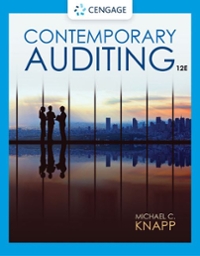Question
1.) Why did Wells Fargo reach a settlement with the federal government to pay out $1.8 billion? Multiple Choice for falsely underwriting millions of home
1.) Why did Wells Fargo reach a settlement with the federal government to pay out $1.8 billion?
Multiple Choice
for falsely underwriting millions of home mortgage loans prior to 2008 that should have never been eligible for Federal Housing Administration insurance
for falsely underwriting thousands of home mortgage loans prior to 2008 that should have never been eligible for Federal Housing Administration insurance
for falsely underwriting hundreds of home mortgage loans prior to 2008 that should have never been eligible for Federal Housing Administration insurance
for denying thousands of home mortgage loans prior to 2008 that should have been eligible for Federal Housing Administration insurance
2.) Why was Wells Fargo’s settlement with the federal government to pay out $1.8 billion significant?
Multiple Choice
It was the largest settlement in FHA history.
It reflected CEO greed.
It was coupled with jail time for the CEO.
It forced Wells Fargo into bankruptcy.
3.) While Wells Fargo downplayed the ruling of $1.8 billion pay out as a good riddance of bad situation, what could Wells Fargo have done instead to signal improving corporate governance?
Multiple Choice
Wells Fargo could have formally declared all the initiatives the company had taken since the financial crisis to build a stronger foundation of corporate governance.
Wells Fargo’s CEO should have accepted the responsibility.
Wells Fargo should have recomposed the board of directors.
Wells Fargo should have hired a different external audit firm.
4.) In the wake of Wells Fargo’s scandal about unauthorized bank accounts, how did Wells Fargo manage the governance crisis?
Multiple Choice
terminated culpable employees
cooperated fully with investigators and regulatory bodies
appointed a third-party monitor
issued a curt apology
Read the case below and answer the questions that follow.
Soon after the financial crisis of 2008, the Financial Crisis Inquiry Commission concluded that the crisis was caused in most part by “widespread failures in financial regulation and supervision” and “dramatic failures of corporate governance and risk management at many systemically important financial institutions” (Lee, 2016). As the second-largest in the US, Wells Fargo was clearly a systematically important financial institution. With sweeping corrective measures in place, it is rather shocking that just seven years later Wells Fargo would find itself a new quagmire of governance crisis pertaining to unauthorized bank accounts.
In 2016, “Wells Fargo reached a settlement with the federal government, agreeing to pay out $1.8 billion for falsely underwriting thousands of home mortgage loans prior to 2008 that should have never been eligible for Federal Housing Administration insurance” (Lee, 2016). Although it was the largest settlement in FHA history, Wells Fargo’s official statement was not issued by its CEO John Stumpf, but rather by its President of Home Lending. As a crisis communications specialist, Lee (2016) views this as “a complete missed opportunity for Stumpf to directly apologize for the company’s part in the 2008 crash and firmly establish Wells Fargo as a trusted institution dedicated to the financial well-being of its customers.” While Wells Fargo downplayed the ruling as a good riddance of a bad situation, Wells Fargo could have incorporated in its official statement a formal declaration of all the initiatives the company had taken since the financial crisis to build a stronger foundation of corporate governance.
Wells Fargo’s governance crisis pertaining to unauthorized bank accounts was brought to public attention when “the federal government and the state of California announced that they had fined Wells Fargo $185 million after discovering employees had opened more than 2 million bank accounts or credit cards without customers’ knowledge over the course of four years—a blatant violation of customers’ trust and security” (Lee, 2016).
In the wake of this new discovery, good governance measures could include termination of culpable employees, maximum cooperation with investigators and regulatory bodies, and appointment of a third-party monitor. Instead, Wells Fargo issued a curt apology: “Wells Fargo is committed to putting our customers’ interests first 100 percent of the time, and we regret and take responsibility for any instances where customers may have received a product that they did not request.” Lee (2016) observes, “Following a public backlash that somehow took Stumpf and his communications team off guard, the company issued a follow-up statement, yet again attributed to no one, and that yet again downplayed the incident, this time without any trace of an apology. ‘While we regret every interaction that was not handled properly, the number of instances and team members involved represent a very small portion of our business,’ the statement concluded.”
Arrogance of Wells Fargo in the wake of such corporate governance does not bode well for the firm. Instead of recognizing governance weaknesses, erecting defense walls is not how corporate governance can be improved in any company. Wells Fargo’s recent governance crisis serves us as a reminder.
Step by Step Solution
3.41 Rating (154 Votes )
There are 3 Steps involved in it
Step: 1
The detailed answer for the above question is provided below 1 Why did Wells Fargo reach a settl...
Get Instant Access to Expert-Tailored Solutions
See step-by-step solutions with expert insights and AI powered tools for academic success
Step: 2

Step: 3

Ace Your Homework with AI
Get the answers you need in no time with our AI-driven, step-by-step assistance
Get Started


